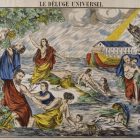Max Blecher’s Landscapes of Illness

Literary myths are often born at the seemingly incongruous intersection of biographical fact and literary achievement. They fascinate because they suggest that lived experience—and the creative capacities that draw on that experience—does not always correspond to our expectations of how a life may be inscribed and circumscribed by its circumstances. The myth of Max (Marcel) Blecher (1909-1938) fascinates in this way because it is a myth based on the question of how a young man, who spent most of his short, agonized life bedridden, and who died at the age of twenty-nine from Pott’s Disease, or spinal tuberculosis, in a small, provincial town in northeastern Romania, could write the collection of poems and the two almost formally perfect novels that Eugen Ionesco compared to the works of Franz Kafka and that today assure his posthumous reputation as one of the great Eastern European writers of the twentieth century.
Ironically, Blecher’s novels themselves are concerned with this question, chronicling the lives of individuals whose bodies are on the verge of collapse and the intellectual, social, and philosophical condition of what his last novel, Inimi Cicatrizate (1937), or, Scarred Hearts in Paul Bailey’s 2008 English translation, calls “an apprenticeship in illness.” Though central to the concern of both books, illness is not their subject as much as it is the occasion that forces their protagonists into a world of previously unavailable experience—rich, strange, grotesque, surreal, melancholy, and fleetingly beautiful—a world that makes it impossible for those who fall ill to ever return to the quotidian reality they once inhabited or to ever be “cured” of the way of being, seeing, and thinking into which they have now been initiated. One might say that, in Blecher’s works, the life of the invalid shapes the sensibility of the sufferer, turning her into someone who begins to see the world in a unique and often acutely uncomfortable way, much like a writer might.
In Întâmplări în irealitatea imediată (1936), or Adventures in Immediate Irreality in the most recent English translation, by Michael Heim (2015), the unnamed narrator describes this peculiar way of encountering the world—which the reader only much later begins to suspect is a kind of “irreality” produced by illness—as a matter of course. It is simply the way the young man, “tall, thin, and pale,” with a “spindly neck [that] rose awkwardly out of my tunic” and “long arms [that] hung from my sleeves like newly skinned animals,” experiences life in the dusty, provincial town he inhabits. If, in the autumn, “the dirty street’s muddy paste still stretched out . . . . [and] houses spread like fans, others resembled cubes of white sugar, and others small, their roofs pulled down over their eyes, clenching their jaws like boxers,” or, if, in the summer, “the air baked by the sun quivered vaporously like the transparent steam hovering over a boiling liquid,” this seems to have as much to do with the “special atmosphere” of the town as it does with the protagonist’s perception of it. Indeed, the reader is encouraged to consider statements such as the above in terms of factual observation, even when—or especially when—they seem outlandish. “The attention I paid to my surroundings,” the narrator insists, “nebulous though it was, was not simply an act of will: the world, as is its nature, sank its tentacles into me; I was penetrated by the hydra’s many arms.” Monstrous and threatening, the landscape of the small anonymous town appears to impose itself on the narrator, who comes to perceive it as a series of “bedeviled places teeming with fits and vertigo” and “benevolent places, places whose walls are lined with lovely images,” all of which participate in “a bizarre feeling of futility” that also characterizes the young man’s condition.
The result of the confusion between what the narrator perceives and feels and what might in fact be there to be perceived and felt is to make the reader begin to suspect that “the [narrator’s] crises belonged as much to the places where they occurred as to [him].” As the distinction between hallucinatory perception and objective description breaks down, reality begins to acquire dream-like characteristics, and dreams take on the qualities of painstaking observation. At one point in the narrative, for example, we are told:
suddenly a man came out of a first class compartment; he was portly and well dressed, had a decoration in his buttonhole, and was wearing a monocle and white shoes. His bald spot was poorly hidden by several strands of silver hair. In his arms he held a white Pekinese, its eyes like two agate marbles in oil. For a while he paraded up and down the platform looking for something. Finally, he found it: a flower-girl. He chose several bouquets of red carnations from her basket and paid for them, taking the money out of an elegant wallet of soft leather with a silver monogram. Then he went back to the train and I could see him putting the Pekinese on the table by the window and feeding it the red carnations one by one. The animal ingested them with obvious relish.
At another point, we are told of “a man in the rain carrying a chandelier with crystal ornaments that sounded like a symphony of hand bells on his back while heavy drops of rain dripped down the shiny facets. It made me wonder what constitutes the gravity of the world.” Of the two, which is the real encounter and which the dream? Is either more real than the other given that both are in some sense reconstituted through the lens of the narrator’s illness?
The nature of this illness is ill-defined. Very possibly it is malaria, but also very possibly, as the narrator himself describes it, it is a normal response to his interactions with a landscape whose true character he feels to be at odds with the way in which it is conventionally experienced. His freedom to wander the town and to have “adventures”—sexual, social, and aesthetic—allows him to break with such conventions, “living a life all my own in a manner unique and inimitable.” Paradoxically, however, these wanderings also increase his disquiet and worsen his “crises” by giving him time to consider the world in its “infinite forms” and in its “futile,” fundamental sameness as “brute matter—in the deep, heavy masses of earth, stone, sky, or water, or in its least understood forms: mirrors, paper flowers, painted statutes, glass marbles with their enigmatic internal spirals.” He becomes “terrorized by [the forms’] diversity” and their essentially identical material composition: “mud.”
The narrator perceives each aggregation of matter as unique, infinitely complex, infinitely interesting, and infinitely valuable, in a democratization of time and space that makes of Blecher’s provincial town the center of the universe and that makes a cornhusk the center of one memorable chapter. In perceiving the infinitely rich and often savage beauty of matter and in identifying with it, however, the narrator also realizes its utter inability to be anything else or more. Herta Műller terms this dual vision “Blecher’s eroticism of perception,” a process by which the protagonist’s “flesh seems to creep into the substance of things . . . and the substance responds with a similar promiscuity,” and in which, “as things themselves become increasingly transparent through his close observation, [the protagonist] becomes less and less transparent to himself.” It might be just as accurate to say that, as the narrator is overwhelmed by the myriad forms available to the senses and feels for them (and sometimes as them), only to then be disillusioned by their material nature (that most fundamental state of “implacable, imperious, elemental mud”), he loses “all knowledge of myself. I stepped into the mud first.” He becomes absorbed into the landscape with which he interacts and identifies with its matter as matter, affirming that “my identity had long been established . . . there was nothing in the world other than mud.” The realization leads him to the brink of despair.
Suspended between dream and reality, or, perhaps, between perceived reality and convention, the narrator cannot be cured of his malaise, since a cure would involve a reconciliation between the infinite complexity of reality, to which sensory experience attests—and which calls for interpretation and seems rich with symbolic meaning—and the radical materialism that it elicits, which affirms both the accidental existence of the self as a conglomerate of atoms and its certain dissolution. More to the point, to cure him, one would have to explain the relationship between the first sentence in the narrator’s following observation and those that come after: “later a few incidents connected with the life here below occurred. In the cemetery, for example, when the corpse in its white shroud was lifted from the coffin, the shroud showed a large patch of blood. Such was the last and least significant episode before the coffin descended to the hold of the cemetery, its warm, moldy basement full of yellow, gelatin-like, purulent bodies.” To the narrator, it seems impossible to explain how the corpse that is being absorbed into the landscape of the cemetery—much like his own body is absorbed into the matter it encounters—is related to its patch of blood; however, it nevertheless does seem possible—and necessary—to him to speak of it. Like Blecher’s own, the impulse to recount is that of a young writer.
If in Adventures in Immediate Irreality the perceived loss of individuality due to the hallucinatory effects of illness fosters a unique, overdeveloped sensibility, in Scarred Hearts, Blecher’s masterpiece, published a year before his death, in the tradition of Thomas Mann’s 1924 novel, The Magic Mountain, illness marks its sufferers irreversibly by numbing not just their bodies but their hearts. Isa, one of the terminally ill patients in the novel, describes the process as “cicatrisation. It’s when scar tissue forms: that dark-coloured and wrinkled skin that forms on a wound as it heals. It’s normal skin, except that it’s insensitive to cold, to warmth, or to touch.” That is what happens to the heart of an invalid, she argues—it becomes “insensitive, dark, hardened.” The novel chronicles this process, but it also seems to suggest that the cicatrization of the heart, which accompanies the progressive immobilization of the body, paradoxically allows the sufferer to grasp a number of fundamental truths about the human condition that are inaccessible to the fit and healthy. The heart may scar, the novel seems to argue, but as one is disabused of every last illusion, one also comes to understand and appreciate “how fragile had been . . . life till then; how insubstantial was the entire reality of the days that had passed by . . . like a quietly-flowing river, whose current [one] could feel within [one’s self] when [one] lay motionless and eyes shut.”
Like Blecher, on whom he seems modeled, Emanuel, the protagonist of Scarred Hearts, is a young Romanian studying abroad in Paris when he realizes that he is suffering from spinal tuberculosis and, at the recommendation of a specialist, relocates to a clinic and sanatorium in Berck-sur-Mer, a place “not on the map, a little sea town where patients like yourself come from all over the world to take their cure. They spend their time lying on their backs, in body casts, but they lead absolutely normal lives. They even go out in carriages, you know, special carriages drawn by horses or donkeys, in which they can lie flat on their backs.” Like other sufferers of various diseases of the bone, upon arrival, Emanuel is encased in a heavy plaster “corset” that, like a hair shirt one cannot remove, becomes “misery as an organic function, intolerable but permanent.” This corset is meant to keep the patient from moving and thus give his vertebrae a chance to heal, but, to Emanuel, it symbolizes early entombment, a kind of living death. He variously refers to himself a “prisoner in a corset,” “a dead man,” “a corpse,” “an animal ready for dissection,” and “a hybrid statue, a strange combination of flesh and plaster.”
As with the protagonist of Adventures, as Emanuel’s situation changes and he begins to fear that he will never be free of his “corset,” his perspective on the world changes, and the world itself appears to alter radically. The process begins with his immobilization in bed, as all “around him he saw his wardrobe, the books and the table, the old familiar things, the well-known things, but now they came unstuck, indecipherable in their murky lucidity, like the chaotic words shouted by an unknown voice in a throng of people crowding out an assembly hall.” In Berck-sur-Mer, the landscape continues to alter along with the protagonist’s inner state, and “the world seemed to have become at the same time dense yet more indistinct,” the seaside town coming to represent both a “foreign autumn” and “an old nostalgia, a memory.” As it becomes part of both an imagined past—a place he feels that he has always inhabited, similar to the “turgid and wearying waters” of his “exhausted half-sleep”—and a probable future, the landscape is transformed into a kind of photographic negative of Emanuel’s inner life, no different from the X-ray of his eroded vertebra, on which “the most intimate, secret structure of his body was printed there in dark, funeral transparence.”
Consequently, the narrator describes Emanuel’s Berck as a watery expanse of beaches and dunes, a place of shifting winds, rain, and liquid sunlight, whose flowing elements suggest both impermanence and elemental freedom. It flashes with the “immense brilliance of the sea…the fantastic shadows of fishing boats, far off amid gold and light.” It “sparkle[s], nothing but crystal and azure . . . . in that inexpressible fullness of immense luminosity—the vast expanse of the air, the infinity of water.” It is a world of hallucinatory beauty and “the utter perplexity of all these places that had no need to explain themselves to anyone.” Its watery indeterminacy reflects everything that both tortures Emanuel and gives him hope. He, too, reads himself into the landscape with which he identifies, imperceptibly aspiring towards its fluidity, even as that fluidity makes him despair. As the corset is applied, he feels the “trickle of water [that] ran down from his shoulders onto his back, making him quiver with its delicate, tactile calligraphy.” As the plaster hardens, however, he also begins to feel that he is “lying in a horrid puddle, as if the dampness is getting under my skin . . . into my bones . . . into my heart.” The dampness never departs, nor does it break through his physical immobility. He identifies it in the body of the lover he tries to take, “her warmth . . . like water trickling through his fingers into the whole of his body.” He thinks of it as he considers his friend, “a sick man” who, “while the morning rose up, immense in its freshness,” “lay on an operating table somewhere as rivulets of blood leaked from him.” He observes it at a funeral, in the “grave [that] was half-filled with water.” In one of the most beautiful passages in the novel, he even imagines the freezing church to which the patients are taken on Christmas Eve as a great ship floating on a watery nightscape: “what would happen, thought Emanuel, if that evening the entire construction were to set out into the world like a ship, sailing the ocean waves, laden with patients, gleaming with light on its final nocturnal journey before the shipwreck, and then drowning along with itself all the plaster, all the infirmities, and all the despair that was gathered together in that one place?” Like the protagonist of Adventures, he answers the question by reducing the simile—and others like it—to “mud”, “forming a thin layer . . . in which all things seemed to splatter, even the air, even the spoken word.”
Eventually, the reader comes to understand that this watery landscape in one sense can be understood as the exteriorization of the current of Emanuel’s life and that, at least in part, it stands for the infinite “vacillations” of fate that make it impossible for anyone “to know for certain . . . live or die?” Quintoce, one of Emanuel’s doomed friends, shrugs off the answer as “a prediction that’s been diluted so much [that it] becomes watery.” As in Adventures, such a landscape can never truly be left behind, much as one’s fate cannot be left by the wayside. Berck is part of Emanuel, wherever in the world he may go. “It gets into your blood. Anyone who has lived here can’t settle anywhere else in the world . . . All the shopkeepers, all the doctors, the pharmacists, even the attendants…all of them are former patients who can’t live anywhere else,” another friend remarks. Because illness is an “apprenticeship” into another life, Emanuel cannot be cured of it even if he is cured of his disease. If by the end of the novel, however, having realized this, “the world’s desolation ha[s] become infinite” for Emanuel, illness has also matured the young man, turning him into a kind of Hans Castorp and the novel into a kind of bildungsroman.



